List of Authors
>>About this blog
Recent blog post
|
[Yo-chan]
December 31, 2018 14:00
1 First
In Chuo-ku, a total of 98 routes, including 43 routes in the Kyobashi area, 45 routes in the Nihonbashi area, and 10 routes in the Tsukishima area, are nicknamed for roads that play an important role as living spaces for residents of the city. The route is set, but this time we focused on the north side of Showa-dori in the Ginza area. By the way, in Chuo-ku, it seems that it was in 1988 that officially named the road. At that time, the names that have been commonly used since ancient times were used as much as possible, and a new "Chuo-ku Road Nickname Setting Guidelines" was newly formulated and guidelines were established. The current outline was formulated in 2002. When we are going to give nickname, we submit to the mayor with documents and are discussed in selection committee, and the mayor will approve. As a criterion for selection, "We will respect widely and commonly used names." "The names of cultural properties, famous areas, slopes, bridges, public facilities, etc., which are generally easy to understand and familiar, use names related to them as much as possible." "In principle, names such as corporate names are not used. "
2 Ginza district road nickname map
The map is handwritten and I think it's unsightly, but please forgive me.
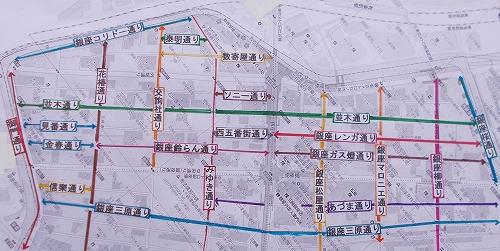
The origin of the 3 Names
(1) Ginza Corridor Street: It was taken from Ginza Corridor Street under the expressway completed by reclaiming the outer moat in 1956. "Corido" means a French corridor, because it looks like a corridor on the west side of Ginza.
(2) Yasuaki Street: It was derived from Yasuaki Elementary School along the roadside, and a request for naming "Yasuaki Koji" or "Yasuaki-dori" was issued by the local community and became "Yasuaki-dori".
(3) Sukiya Street: It is based on the old town name "Sukiyabashi-cho".
(4) Hanatsubaki Street: Shiseido invested in maintenance funds, etc., and named Shiseido's symbol "Hanatsubaki" as the street name.
(5) Kojunsha Street: There is a Kojunsha building along the road.
(6) Sony Street: There is a Sony Building along the road.
(7) Namiki-dori St. : We planted a row of Western-style trees (Platanus) in Sojuro-cho, where village headman Sojuro Uchiyama lived in the early Edo period.
(8) Street: As an office of a union consisting of restaurants, geisha, and Okiya in Shimbashi Hanayagikai in the Meiji, Taisho and Showa eras, "Miban" was on this street, and at that time played a central role in this area.
(9) West Fifth Avenue Street: We added West Ginza's "West" to "Gobangai", which was popular in New York.
(10) Ginza Brick Street: The familiarity of Ginza Brick Street, which was the source of Ginza's prosperity in 1877, and the memory of the warm brick street will be preserved for future generations.
(11) Gomon Street: In 1710, there was the Shibakuchi Gomon, which was built in Shimbashi Kitazume as the gate of the Tokaido.
(12) Kinharu Street: In the Edo period, there was a mansion of Noh's Kinharu style.
(13) Ginza Suzuran Street: It was named after the appearance of many shops lined up in bells like a lily of the valley.
(14) Ginza Gaslight Street: In 1874, the first gas lamp was turned on in Tokyo. The nickname of "Ginza Gaslight Street" was set in 1993.
(15) Shinraku (Shiga Raki) Street: Facing the entrance at Shibakuchi Gomon in the Edo period, there was a resting place "Shinraku Chaya", and it was called "Shinraku Shinmichi".
(16) Azuma Street: According to the name of the town association, "4-chome Higashi-cho". It is because of the private land of Mitsukoshi that there is no indication on the way.
(17) Ginza Mihara-dori: In the past, the Sanjuken River flowed, and there was a bridge called Mihara Bridge.
(18) Miyuki Street: Emperor Meiji went to Tsukiji's Naval School, Suikosha, and Naval Medical School.
(19) Ginza Matsuya Street: Matsuya Department Store invested in the maintenance funds and named it.
(20) Ginza Marronnier Street: There are many shops and buildings in the Ginza area that resemble Paris on the street, and Paris's representative Marronnier was named in the street name. Marronnier is still planted today.
(21) Ginza Yanagi-dori St. : Willow trees are planted on the street trees.
(22) Ginza Sakura-dori St. : Cherry blossoms are planted on the street trees.
4.
Many of the streets with the nickname include the Ginza Hanatsubaki-dori Shopping Promotion Association, the Ginza Miyuki-dori Beautification Association, the Ginza Suzuran-dori Shopping Association, etc. We are making efforts to revitalize the region, such as holding events. I would like to enjoy the silver bra in one corner of my heart that the steady activities of these people are the source of the bustle of Ginza as a whole. 。
[Hanes]
December 31, 2018 09:00
Hello. This is a new correspondent, Hanes. 
This year was the end of the year in no time, but how are you all going?
I think you may be busy preparing for New Year's Day.
When it comes to buying Datemaki, Kazunoko, Kurikinton, etc., which are indispensable for New Year's cuisine, it's time to buy
"At the end of the year! It's Tsuiji.
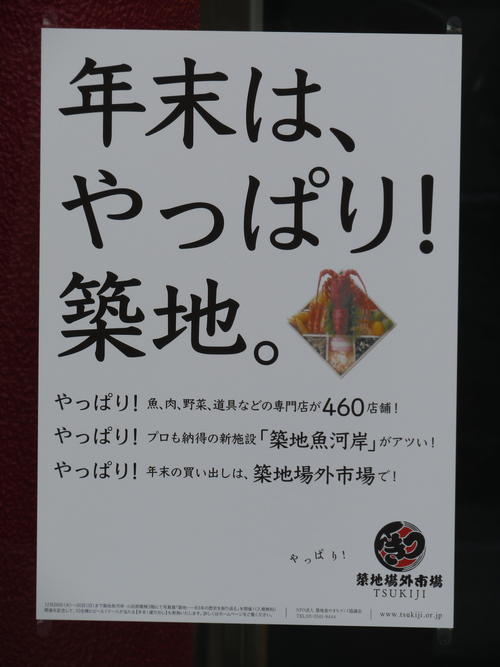
So, on New Year's Eve, I greeted Tsukiji Honganji, where you can hit the bell of nighttime, and then gave a greeting.
(* Bell bell towers will distribute 350 numbered tickets (one shot per ticket) from 22:00 on New Year's Eve. Click here for more information.
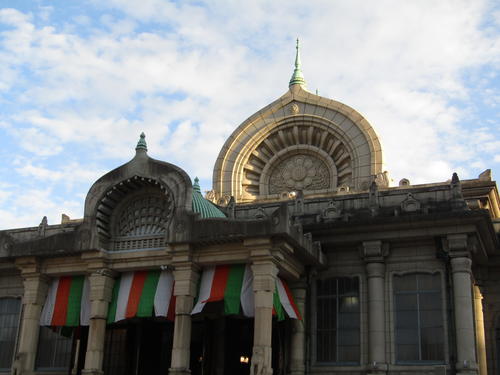
Even after the relocation of Toyosu, I went to Tsukiji Outer Market, where the bustle did not decline.
You can try to line up in a large line of more than 50 people in front of a long-established egg-yaki shop.
In another famous egg-yaki shop, I saw many clerks busy packing boxes for shipping.
There were more crowds than usual, and I was able to enjoy the lively Tsukiji.
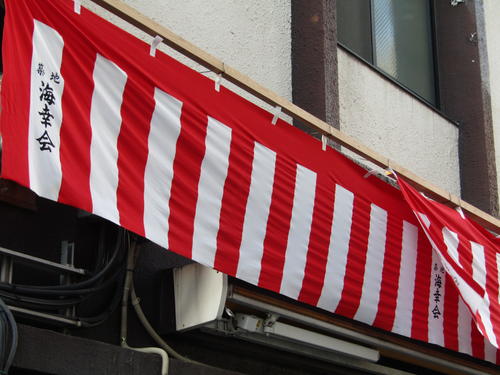
After that, we headed for Tsukiji Namishi Inari Shrine!
During the Manji period (1658-1661), landfill work in the Tsukiji area was not easy due to the waves, but as a result of worshiping the statue of Inari Myojin, which came out of the sea, the waves subsided.
This shrine was founded because it was able to proceed with construction.
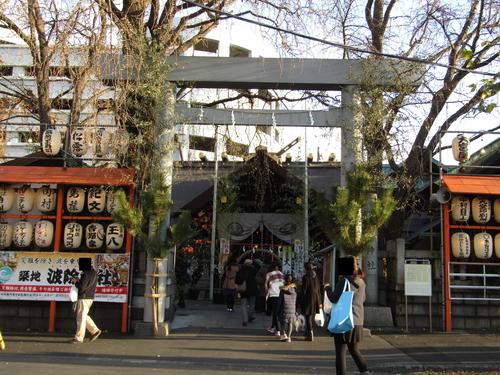
The New Year's great exorcism ceremony is held until the 31st.
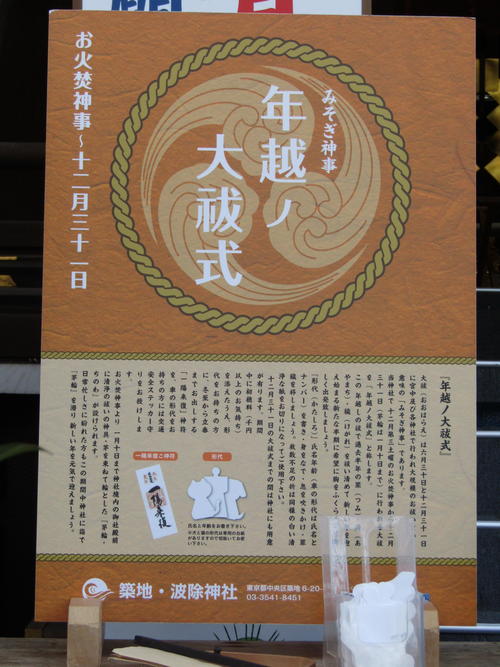
You can go through Chinowa.
Why don't you pray for sound health and others for the new year?
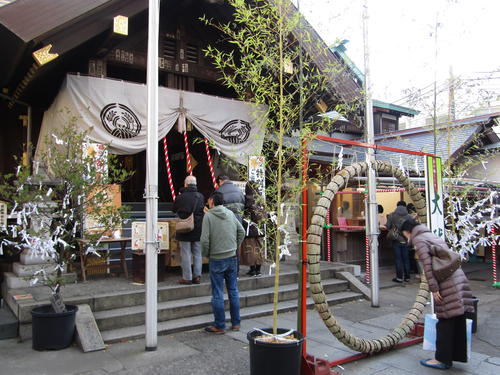
You can also visit the protection against misfortune ceiling large lion (wish skewers).
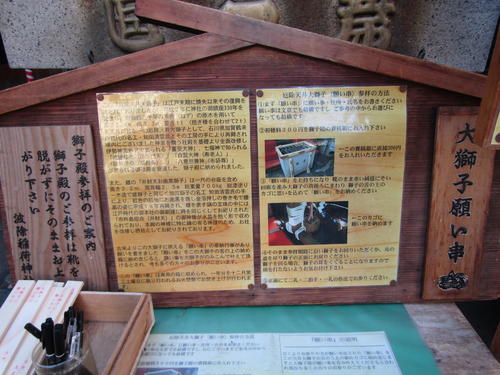
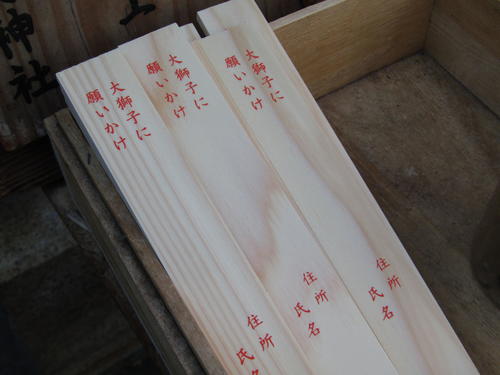
Put the wish skewer that wrote wish in the basket on the tongue of this large lion, and remember,
It is said that a large lion will swallow wish and fulfill it.
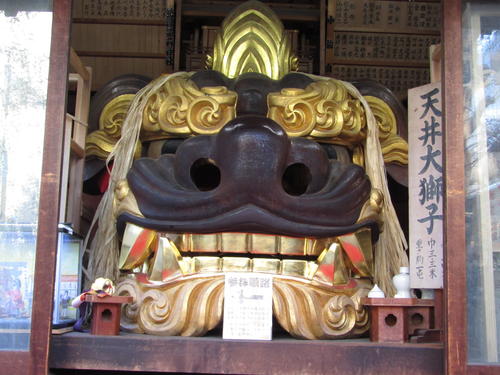
The large ceiling lion is male and has a corner at the top of the head, and the black lion is female and has a giboshi.
This shrine has cultural properties that we want to keep as a measure against the Chuo-ku sightseeing certification.
If you have a chance to come to visit, check the large lion and the water bowl.
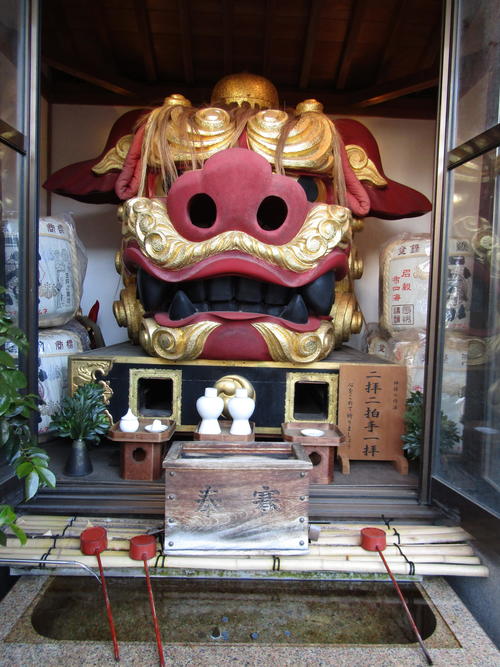
And the Chinese zodiac sign in 2019 is also near the ceiling large lion.
Why don't you take a look at this as well?
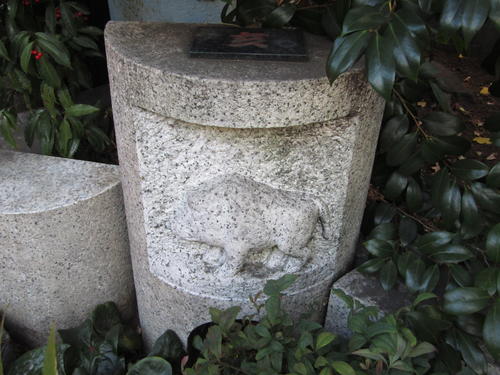
Recently, I heard that there are towns in the Kanto region that have suddenly cooled down and recorded 60 cm of snow.
When you go out, wear it like a calf sparrow and warm it out!
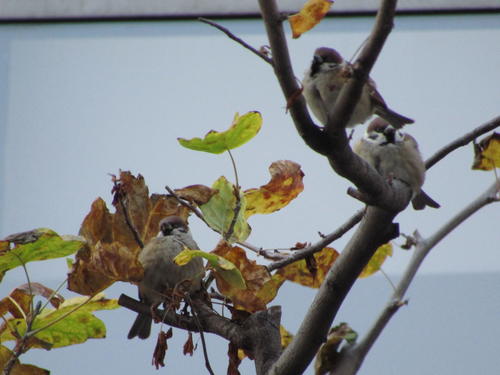
Photographed in front of the Tsukiji Social Education Center.
[saru]
December 30, 2018 18:00
From December 26 to 28 in the New Year, there was a year-old market around Yagenbori fudoson in Higashinihombashi. The year-on-ichi has continued since the Edo period, and it was once called the year-on-ichi that paid since Fukagawa Hachiman, Asakusa Kannon and Yushima Tenjin and ended in Yagenbori fudoson in December. Right next to it is Ryogoku Hirokoji Temple, which was one of the best places in Edo, and in the past it seems that stalls sold New Year's goods such as Hagoita and shime decorations, but now the location of the wholesale district and winter clothes are at a reasonable price.
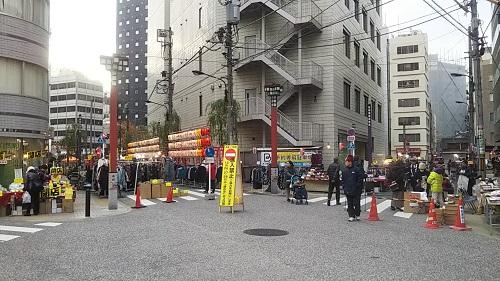
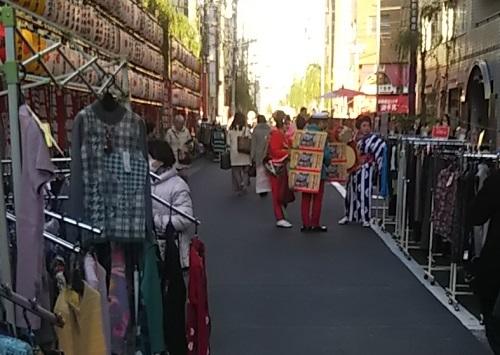
There is also a monument of the old city in the precincts of fudoson.
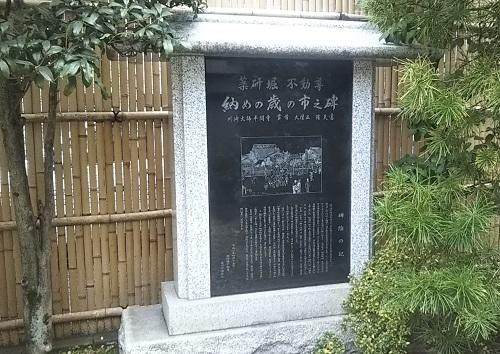
There is also a monument commemorating the birth of the talk in the same place.
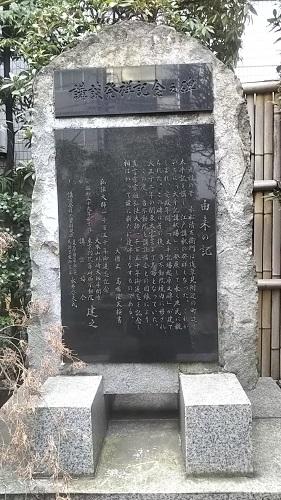
It is said that the talk originated from Tsuji Kosha at Ryogoku Hirokoji during the Edo period, and from such a connection, on the evening of the last day of the city on the evening of the last day of the city, many lecturers gathered at the memorial service of Zhang fans used in the talk. It was done in front of the monument. After homa was cooked and read, the participants wrote the wish on the fan-shaped paper and put them in the fire of homa for the best of next year.
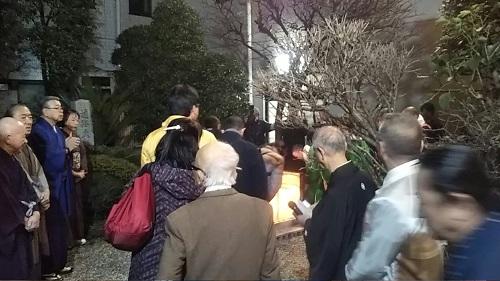
Then, in front of the gate, under the name of Tsuji Kosha, the current lecturers showed the change of Honnoji Temple and a seat of Miyamoto Musashi.
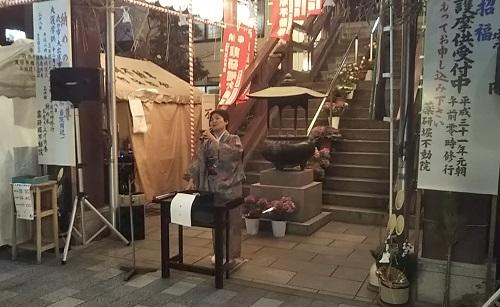
It was cold because it was an outdoor event, but I bought alcohol and hot drinks at the stalls and enjoyed the warmth.
Now, the talk seems to be a boom, but it has a different taste from rakugo, and there are many things that deal with historical celebrities, so it is also a study. In Yagenbori fudoson, it seems that a meeting is held about once a month. Edo Nihonbashi-tei in Nihonbashi is located in a theater where you can easily go to Chuo-ku. From New Year's Day, he will have the first meeting of the Kodan Association. Why don't you visit the entertainment hall once because it is a traditional performing art originated in Chuo-ku?
[Hanes]
December 29, 2018 09:00
Hello. This is a new correspondent, Hanes. 
This time, we will focus on songs and catchphrases, and introduce useful information for Chuo-ku sightseeing certification measures!
First of all, it's a song, but I don't say you should remember everything.
At least, let's keep the lyrics, composition, singers (if you have a representative person), and singing lyrics!
(If you can afford it, it may be a good idea to keep the performance of the lyricist / composer and the lyrics of other parts.)
■Willow in Ginza
Lyrics: 80 Saijo, composed: Shinpei Nakayama
"♪) Remnants of Yanagi Edo in Ginza who are happy to plant"
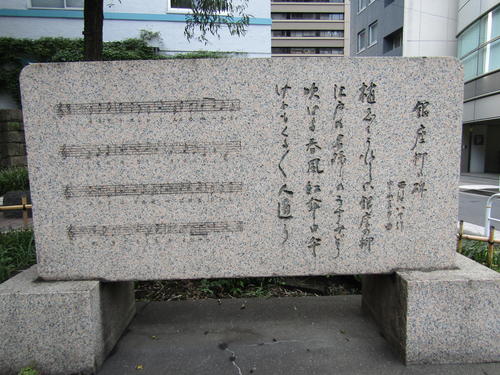
[Related Articles] [4th Excursion Series] The edge of Ginza's Yanagi Nisei's in Ginza
■This is Edo's Bon Dance
Lyrics: Toyohisa Araki, composed: Shosuke Ichikawa
"♪) Ha ~ This is a little dance in the middle of Tokyo, Bon Dance"

[Related Articles] Rediscover the charm of Chuo-ku! Bon Odori in Hatchobori and Kyobashi
■The story of love in Ginza
Lyrics: Hisao Otaka, composed: Kaburagi Sou, Song: Yujiro Ishihara, Junko Makimura
"♪) (female) a whispering that numbs to the bottom of the heart (male) a breathless sigh."
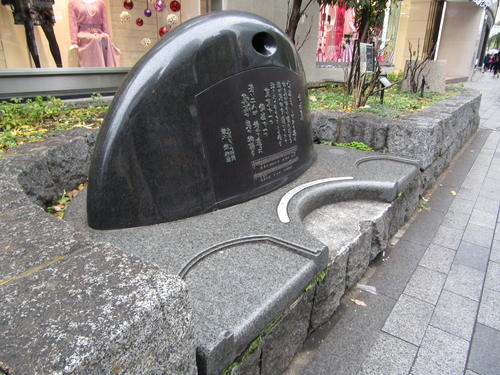
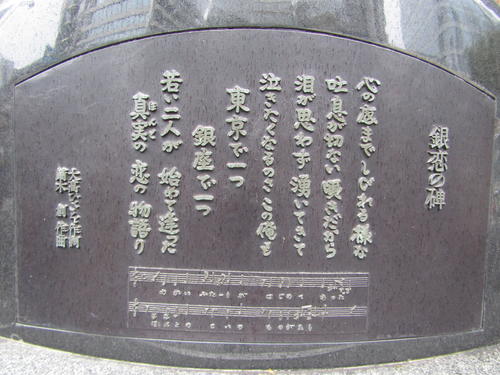
[Related Articles] Dimini ☆Mr. Cricket "The tour of poetry monument in Ginza"
■Bon Dance Song of Tsukuda Island
This Bon Odori is characterized by a monotonous rhythm turret drum and an oral song like a memorial Buddha.
It is sung as "Autumn field separation is an impermanent wind, if it scatters, everyone will not remain, and if it is enlightened, the vegetation will be the land, and the Buddha will be the southern Amitabha Buddha."
Next is the catchphrase, etc.
■Mitsukoshi Nihonbashi Main Store
Click here for a copy of the advertisement that was featured on the flyer of Japan's first Western-style theater "Imperial Theater"!
"Today is the Imperial drama tomorrow is Mitsukoshi,"
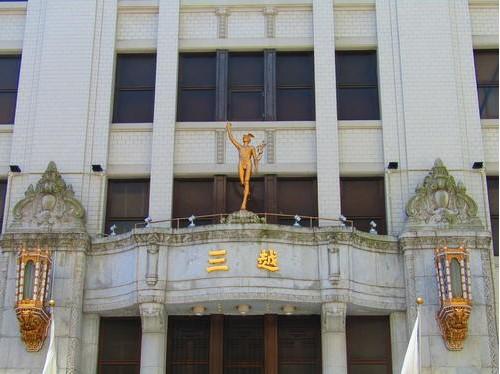
■Takashimaya Nihonbashi Store
The store newly built in 1993 (2 basement floors and 8 floors above ground) was designed by Sadataro Takahashi.
The entire building is fully equipped with air conditioning and heating, and here is a popular advertising copy!
"It's hot in Tokyo, where I left Takashimaya."
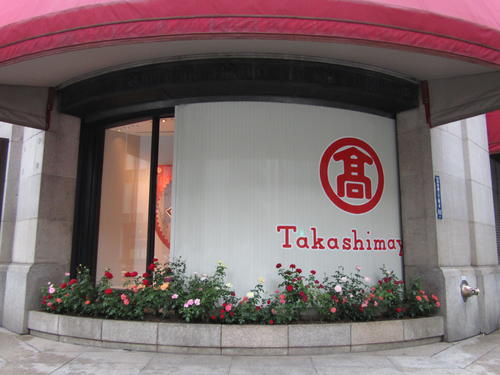
(The state of Takashimaya just before the opening of the store)
■Nihonbashi Fish Bank
Along with the daytime playhouse and Yoshihara at night, it was called "a place where a thousand cars fall in one day."
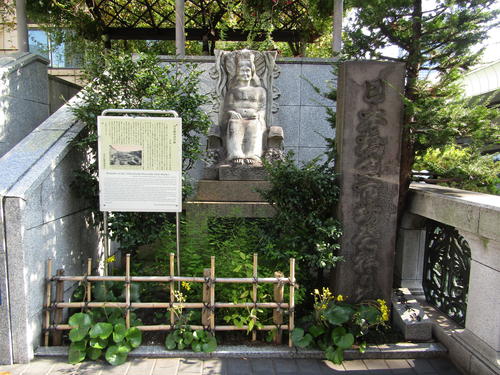
[Related Articles] "Chuo-ku x Spain (2)-Nihonbashi seen by Rodrigo-", "[9th excursion series] Island connected by fishermen"
■Suitengu Shrine
In the Edo period, there were many people who threw money through fences....
Therefore, only on the 5th day, the Arima family's residence was opened to the general Edo kid, making it possible to worship.
It came to be called like this
"Suittengu of the mercy,"
[Related Articles] Sam "2018 Suitengu Setsubun Festival", Edamame "Daughter Azuki's Shichigosan, 3: Visit at Suitengu. (Half, anti-professional)."
■The town of Edo where wooden houses are densely packed
As typified by the great fire of the Meiryaku era (January 18, 1657), there are very many fires in the town of Edo.
It was said, "Fire and fight are the flowers of Edo."
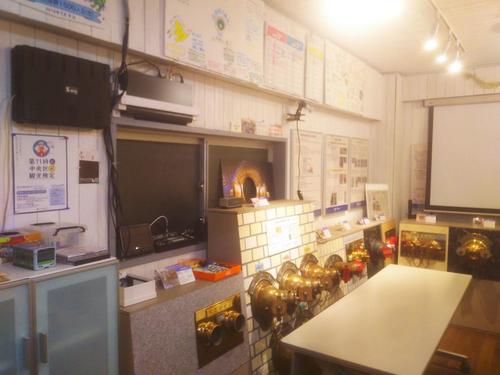
(With the kindness of the director of the water entrance museum, Minato-ku also puts a flyer for the Chuo-ku sightseeing certification and promotes it! Thank you very much . .
[Related Articles] "Chuo-ku in the History of Fire Fighting (Part 1)"、"Chuo-ku in the History of Fire Fighting (Part 2)"
■Gas lamps
In 1874, the brightness of the 85 gas lamps lit in Ginza was expressed as follows.
"I changed the night to day,"

■A lantern
The work of Seibo Kitamura, which was installed at Sukiyabashi Park as a memorial tower for the 10th anniversary of the Great Kanto Earthquake.
A statue of a young man wearing a helmet holding a torch and watching a lion.
Even though it is small, the strength is transmitted.
What is written on the bronze casting nameplate of the pedestal is "continuous preparation for unexpected earthquakes."
[Related Articles] Yotaro "Around the Earthquake Reconstruction Memorial Tower Seibo Kitamura" Lighthouse "", GPP "I visited Seibo Kitamura's work (Lighthouse & Peace Memorial Statue)"
■Edo kid temperament (Kyoden Santo)
"I saw the killer whale of Edo Castle and made tap water as a hot spring." "I don't have any money for evening."
"Food and play equipment are luxurious" and "Natural Edo no Hanuki"
Let's also check "Ikito Harima is the main territory"
■Nihonbashi
The magazine "Remarks in Gofunai" compiled by the Shogunate states, "This bridge is in the center of Edo, and the process of the countries is determined here, so Nihonbashi's name is Tofu."
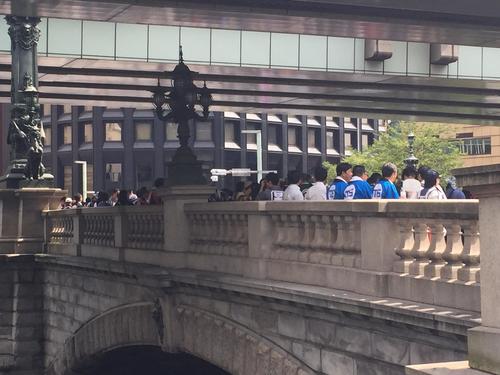
How did you like that?
These are not all songs and catchphrases related to Chuo-ku, but they are not all.
Like the previous Haiku and Kawayanagi, there are many impressive things.
When walking around the town, be sure to check these out.
※In this article, we will introduce some of the reasons for this.
If you learn the contents written here, you will not be able to pass it.
Please include it in advance.
[Hanes]
December 28, 2018 18:00
Hello. This is a new correspondent, Hanes. 
The date of the Chuo-ku Tourism Examination Examination is approaching, but is your study progressing smoothly?
This time, I will introduce you to visiting historical sites in Chuo-ku, which also serves as a measure against Haiku and Kawayanagi.
■Mrs. Takeko Kujo, poetry monument
She was born in Kyoto as the second daughter of the gatekeeper of Nishi Honganji Temple and married Baron Yoshiyuki Kujo at the age of 21.
My husband has been living separately for nearly 10 years due to studying and working in the UK.
During that time, I studied Waka (Nobutsuna Sasaki), Painting (Shoen Uemura), and Ikebana (Nishikawa Ikusatei) and refined my talents.
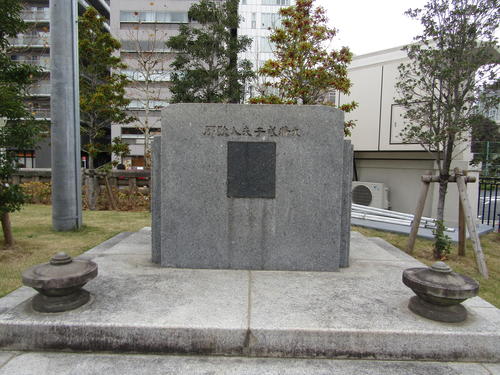
The songbooks she left include "Kinsuzu" and "Kaosen" and the essay "Muyuka".
I would like to keep in mind the "Overy Things I'm going to be drawn from the great things" engraved on poetry monument in Tsukiji Honganji Temple.
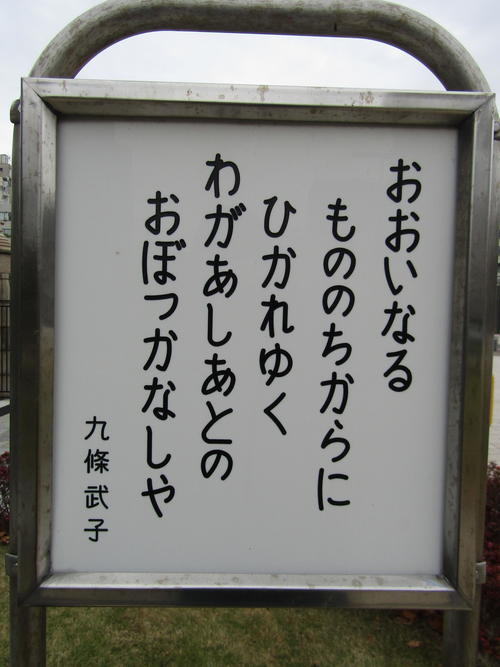
■Kawayanagi, Mizutani Ryotei stone monument
His phrase, worried about the customs of Tsukuda Island and talked about Setsuyoshi Tadataka at home, can be seen on the grounds of Sumiyoshi-jinja Shirine.
"I'm a gentle and hard man,"
■Bronze bell at the time of Kokumachi
This bell was installed in Honishi-cho during the time of the second shogun Hidetada Tokugawa, informing the people of Edo Castle of the time.
Because there was Nagasakiya (Dutch trading post's post office) nearby, Kawayanagi was written....
"I can hear the bell of Kokumachi to the Netherlands."
■poetry monument Takuboku Ishikawa
He joined the Asahi Shimbun in Takiyamamachi, Kyobashi-ku (currently Ginza 6-chome).
For about three years until he died at the age of 26 due to pulmonary tuberculosis, etc., he worked as a proofreader while working as a proofreader.
"Iss of the time when I became a newspaper light in Takiyamamachi in Kyobashi"
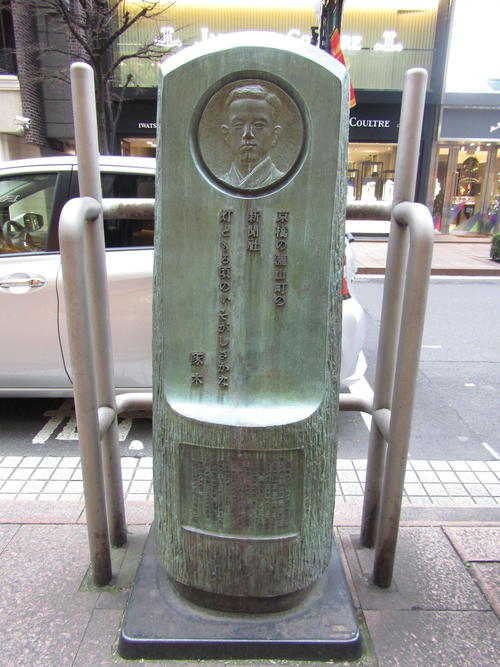
In addition, his first songbook, "A handful of Sand," begins with "Crying up by the white sand of the shores of Kojima in Tokai and hitting crabs."
■Echigo-ya
Enomoto (Takarai), one of the Juetsu Shomon and a representative of a group called Edoza (which features a flashy phrase that reflects the Edo kid's temperament), wrote such a phrase about Echigoya. .
"Echigo-ya's sound and clothespin,"
The scene seems to suddenly come to my eyes.
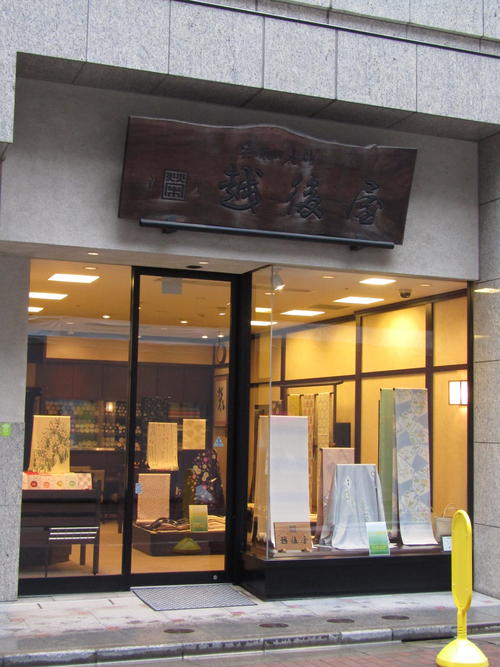
It's a great deal, so let's remember the other phrases at the corner together.
(We will not explain in detail here, but we recommend that you also check the background where each phrase is written!)
"The path of the crane is as expected in the spring of the sun."
"There is no day when one bell can't be sold, spring in Edo"
"I wonder if this number of boats will be cool."
■Site of Kaikaikan
Kaikaikan, which opened in 1905, is a two-story wooden ryokan in Kappo cuisine, which was relocated from Sendai City.
At that time, this area was a scenic and quiet place with a panoramic view of Tokyo Bay, so famous cultural figures stayed there.
The following is a summary of the Kaikaikan:
"Let's see the winter sea and make the New Tsukuda Sea Water Museum wabi live."
(From Isamu Yoshii's songbook "Poison Utsugi")
■19 tombs
On the left side of his tomb (Shinenzan Toyo-in), the creator of Tokaido Naka-Kurige, is located.
The phrase of a famous dictionary is engraved.
"Goodbye to ashes with the smoke of incense stick in your spare time."
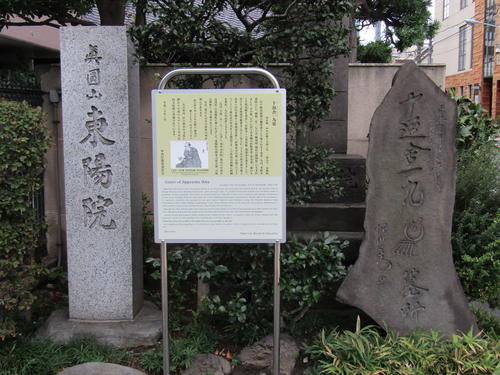
■The end of Shoin Yoshida
Despite being an excellent man who raised many of the late Tokugawa shogunate soldiers, his resignation phrase, executed in the Kodemmacho prison, is set up in Kodemmacho.
"The body is kept in the Nobe of Musashi even if it does not decay,"
■Sushi
Such a phrase was written because the hand of the craftsman holding the sushi resembles a spell of ninjutsu.
"Vinegar rice held by the body of magic" (Kawayanagi haiku collection "Shufu Yanagi Taru")
I've picked up Haiku and Kawayanagi so far.
All of them are impressive things that are memorable.
If you have a phrase you don't know, why not check it before the test?
※In this article, we will introduce some of the reasons for this.
If you learn the contents written here, you will not be able to pass it.
Please include it in advance.
Valuable Information| Ningyocho, Hamacho, Higashinihombashi area| Tsukuda, Tsukishima, Kachidoki and Harumi areas| Nihonbashi, Kyobashi and Yaesu areas| History, culture| Tsukiji, Shintomi, Minato area| Kayabacho, Hatchobori, and Shinkawa areas| Ginza area
Page top▲
[Hikoharu Co., Ltd.]
December 28, 2018 12:00
This time, we are planning to walk along the traces of a river that once existed in Chuo-ku. And this time the target is the Kyobashi River. The Kyobashi River, like the Sotobori River, is said to be a waterway that was excavated during the Keicho era. From the Sotobori River, the current border between Yaesu 2-chome and Ginza 1-chome was east, and at the end of Shiraoi Bridge, it joined Kaedegawa and Sakuragawa (Yachimachibori) Sanjumabori. Speaking of Shiraoibashi, it is also famous as one of Mitsuhashi.
Danshobashi ⇒ Kaedegawa Shiraoibashi ⇒ Kyobashigawa Shinpukuji Temple Bridge ⇒ Sanumabori
This time, we will walk from the site of Shiraoibashi to the vicinity of Sotobori-dori St.
In this Kyobashi River, there were bridges from the east (Sakuragawa): Shiraoi Bridge, Shinkyobashi, Sumitani Bridge, Kyobashi, Konya Bridge, and Jobe Bridge. And on the banks of the river were bamboo banks and radish banks. However, it was reclaimed from 1954 to 1959 and is now part of Tokyo Kosoku Doro. This highway is connected to the Metropolitan Expressway Urban Loop Line and the Yaesu Line. Tokyo Kosoku Doro is a private company engaged in real estate leasing business for buildings on the rooftop of free highways. I think there are some maps that are often described as KK lines.
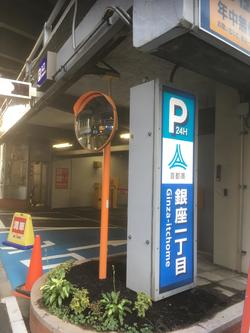 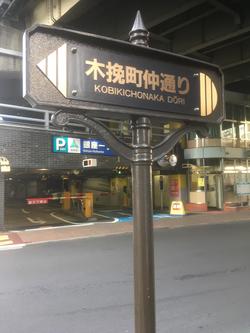
The photo above is a photo of the parking lot of Ginza 1-chome, but this jurisdiction was Metropolitan Expressway Co., Ltd. There were Shinkyobashi Exit and Higashiginza Exit of Tokyo Kosoku Doro ahead, so I think the real estate leasing business at high speed ahead is under the jurisdiction of Tokyo Kosoku Doro Co., Ltd.
And the street in front of you will be "Kibikicho Nakadori". It is said that Kibori-cho, which used to be on the east side of Ginza, was renamed Higashiginza to Nishi Ginza when Sanjumabori was reclaimed. In this way, it would be hot if the old town name was left in the street name. Then, follow the Kyobashi River ruins toward Sotobori-dori St. and cross Showa-dori. It is just near the site of Shinkyobashi.
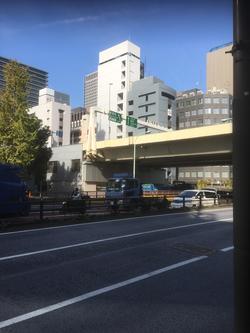 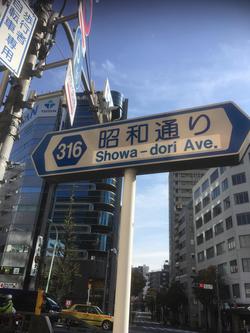
And I found a public bath "Ginza Yu" just a little from Showa-dori.
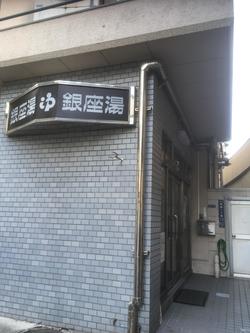
I was surprised that there was a public bath in Ginza 1-chome. But please be assured even in Ginza, the bathing fee is 460 yen for adults common in Tokyo. I couldn't take a bath this time, but men's bath's mural is the Sumida River Fireworks at the ladies' bath intersection of Ginza 4-chome. I want to take a bath at least once!
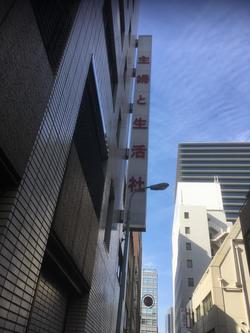 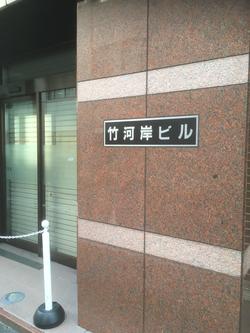
Then go on the left bank of the Kyobashi River ruins toward the Sotobori River ruins. I saw the signboard of the "Housewife and Lifesha" building and the bamboo riverbank building. Yes, this area prospered as the "bamboo riverbank" and it became around. During the Edo period, bamboo merchants gathered here, so it was called "Bamboo Riverside".
In addition, there is a famous police museum beyond that. Admission is free. Please come and visit us. A police car will meet you.
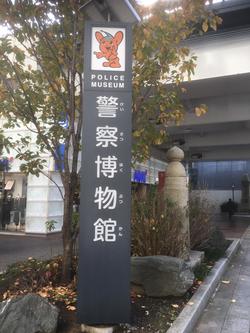 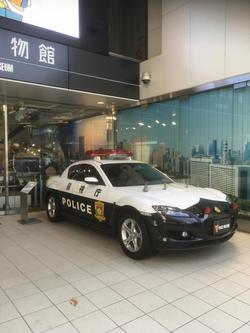
There is already Kyobashi in front of you. Kyobashi is said to be a bridge built in 1603, the same year as Nihonbashi. There are a number of historic sites around Kyobashi.
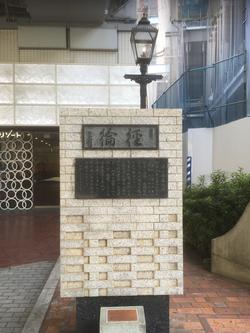 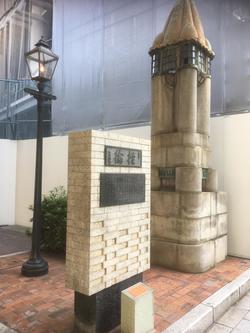
First of all, it is a monument of brick Ginza. With the great fire of Ginza in 1872, the Ginza Brick Street will be further promoted, and the brick street along Ginza Street will be completed in 1873. Behind the monument, a gas lamp illuminating the brick street has also been restored.
In addition, there are currently three main pillars in Kyobashi. The lower left photo shows two main pillars with giboshi on the stone arch bridge in 1875, and one main pillar of the 1922 Art Deco-style bridge next to the monument in Brick Ginza.
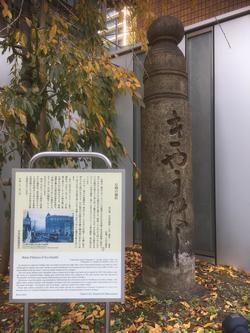 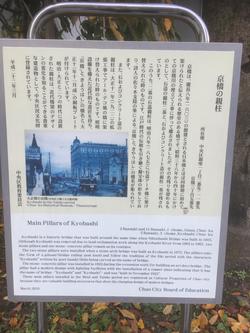
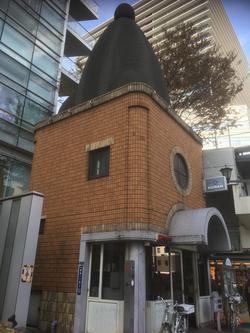 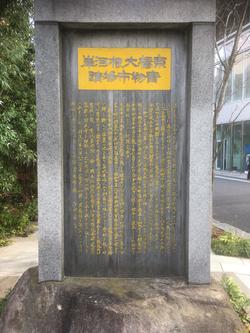
The police box next to Kyobashi imitates the main pillar of an Art Deco-style bridge in 1922.
The right side of the police box photo is a monument to the site of the Kyobashi Daikon Riverside Blue Market.
Since the Edo period, Kyobashi has been listed on vegetables mainly in radish, and there was a green market until before the Great Kanto Earthquake of 1923. It will be relocated to the former Tsukiji Market in 1935. And this year, it will be relocated to Toyosu Market in 2018.
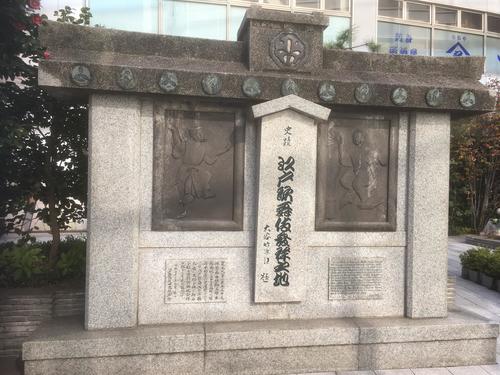
This monument is a monument to the birthplace of Edo Kabuki.
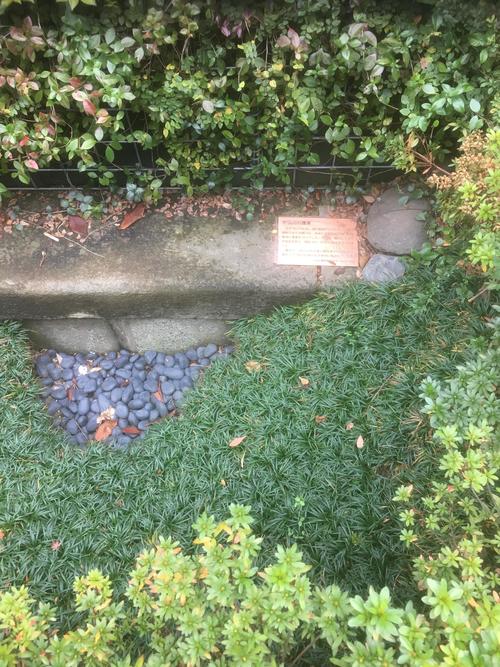
And there is a "Kyobashi River revetment" behind the monument at the site of the Kyobashi Daikon Riverside Blue Market. The copper plate in the photo was described as follows.
"Revetment of Kyobashi River"
"The Kyobashi River, which was excavated after Ieyasu Tokugawa entered Edo in 1590, had a riverbank on both banks and was an important river for logistics in the castle town. After that, it entered the modern age and finished its role, and was reclaimed from 1986 to 1940.
A part of the revetment has been reloaded since the modern era, and remains underground as it was at the time of landfill. " "Chuo-ku Environmental Civil Engineering Department Water and Green Division"
I was able to see the remain of the Kyobashi River this time.
In this way, the area near Kyobashi is a treasure trove of historic sites. If you look closely at the wording of the monument, it will pass an hour immediately.
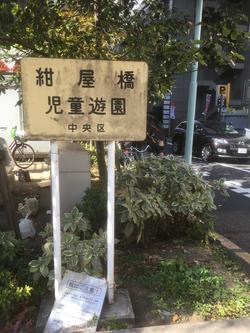 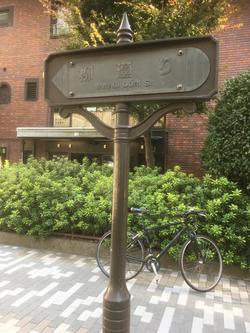
After passing Kyobashi and head toward Sotobori-dori St., you will cross Yanagi-dori St. This area is the ruins of Konya Bridge. In the upper part of the left bank, there was Konyabashi Children's Amusement Park, where the name "Konyabashi" remained. Of course, it was a park that used the site of Hashizume Square in Konyabashi.
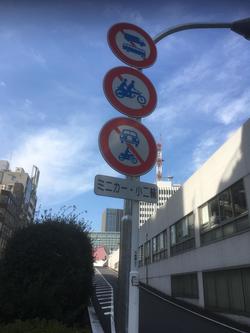 
The photo above is a photo of the entrance to Nishi Ginza in Tokyo Kosoku Doro, but I don't have a signboard with the green Nishi Ginza like the Metropolitan Expressway, so I'm the only one who feels hard to understand and difficult to enter? Everyone, please be careful when driving.

From now on, go along Ginza Sakura-dori St. on the right bank of the Kyobashi River to Sotobori-dori St. The site of the Kyobashi River was crowded with many commercial facilities and eating and drinking facilities.
And right in front of you, the traffic light of Yurakucho arrives at Sotobori-dori St.
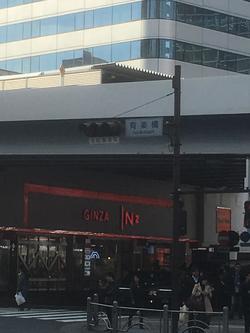 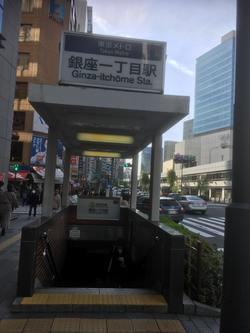
This walk has also arrived at the end of the city. The Kyobashi River was reclaimed for the construction of a motorway by Tokyo Kosoku Doro Co., Ltd. And under the highway there were parking lots, commercial facilities and beverage facilities. In the past, the only thing that made us realize that the river existed there was was the Kyobashi River revetment in Kyobashi. However, it was a town walk that guessed the existence of the Kyobashi River based on the names of the Takegawa River Bank Building and Konyabashi Children's Amusement Park.
|
Links
|





















































